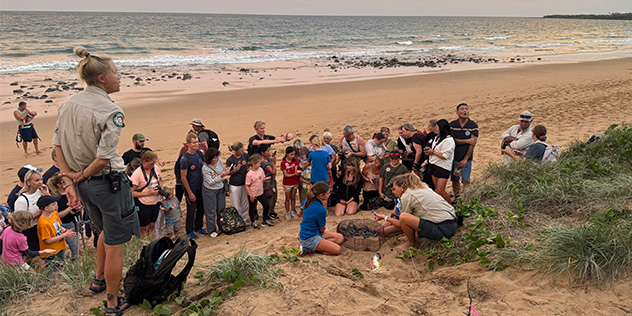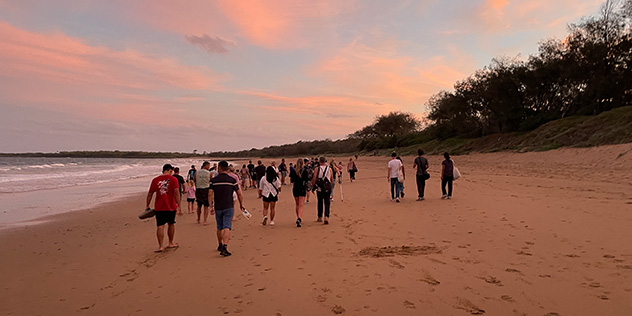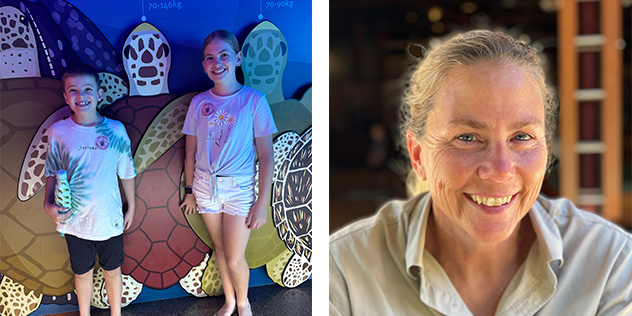Close encounters of the turtle kind

We’ve only just checked in at the NRMA’s Turtle Sands resort and we’re running a little late for our Turtle Encounter on the northern end of Mon Repos Beach. When we join our tour group, they’ve already formed a circle around the loggerhead hatchlings, which are contained within a small temporary fence. On the sandy slope above, a ranger talks about the life cycle of these adorable little creatures, which are swarming all over one another, tiny flippers flapping, eager to make their first inaugural pilgrimage to the sea.
Kids in blue shirts, volunteers from local schools, keep a close eye on the baby turtles. When the ranger has finished her talk, a few kids each remove a turtle from the pen and bring it around so our goggle-eyed gaggle can take photo (permitted before sunset) and get a ‘high five’ – the turtles’ tiny yet surprisingly powerful flippers touching the palm of their hand.
Willing the hatchlings to the water line
The ranger guides us further along the beach, where two lines are drawn perpendicular to the shore. We’re invited to line up on either side of this ‘runway’, while the volunteers and a few handpicked kids from the tour stand in the middle, legs wide, with a torch shining downwards on the damp sand.
The hatchlings, which have been transferred from their pen to a bucket, are now released at the feet of the first child in this lighted gauntlet. Turtle hatchlings naturally seek out the lowest light source (usually the horizon above the sea) so that they head in the right direction, and the torchlights mimic this.
We’re privileged to watch 71 loggerhead babies propel themselves along the sand. Statistically speaking, only one in 1000 will survive to sexual maturity, so it’s just as well a mother turtle lays hundreds of eggs in a season.
The last in our line appears to be a little weaker than the rest. He slows as he nears the water line and the entire crowd wills him along. There’s a shared sense of delight and relief when the incoming tide slides up and engulfs what has become a tiny shadow in the deepening dusk.
We head back up to Mon Repos Turtle Centre in near dark, the ranger’s lights pointed at the ground our only source of illumination. Since 1968, generations of scientists and volunteers have studied the loggerhead turtle life cycle and discovered light can have a marked effect on nesting and hatching behaviour.
The female turtles will cruise the waters offshore looking for a dark, safe spot to nest and bright lights are a deterrent. Flash photography, and even infrared cameras, can cause hatchlings to scatter after they hatch instead of heading for the water. So photos and video are forbidden once the sun is setting and the turtles are released.
Patience, torches and tape measures
Mon Repos Turtle Centre includes a kiosk with drinks and snacks (we were extremely lucky to head straight onto the beach and see a clutch commence their sea lives, but nature doesn’t run to a timetable and the Turtle Encounter can involve a lengthy wait and a late night). The centre also has a discovery zone where you can see the size of various turtles relative to a fully grown man – loggerheads, by far the most common sighted on Mon Repos, can grow to 114cm and weigh as much as 146kg. Hard to believe they start out life as something that can fit in the palm of a child’s hand.
As well as information on turtle conservation and the history of the program at Mon Repos, the Turtle Centre provides up-to-the minute updates on numbers and nesting activity for each night and that season. The ‘scoreboard’ for the Woongara Coast during our visit indicates 313 nesting loggerhead turtles, 11 flatback turtles and over 200,000 hatchlings (turtles nest multiple times each season).
Most are tagged, so we know that while our hatchlings were making a break for the open ocean - turtle QB34879 came up on Mon Repos for the first time and laid 64 eggs as part of her first breeding season. Collecting this information requires a dedicated army of people with head torches, tape measures and, one assumes, an abundance of patience and a head for figures.



A half-century of study supports the symbiotic approach
What effect does our presence have on the turtles’ behaviour? It’s a question I put to ranger-in-charge, Cathy Gatley, the next morning.
“The research program began here in 1968. The head scientist, Colin Limpus, came from an education background, so he saw the importance of allowing people to experience what was happening here,” Cathy explains. “Then, as it became more popular, we realised we had to manage the visitation to make sure we weren’t impacting on the turtles.
“There’s been lots of studies done over the years on what works best with a group of people around during different stages of nesting. At different stages you can do different things. [With a nesting turtle] you need to stay out of the turtle’s line of sight, keep your lights off or just have a low light from behind until she settles into her egg laying. Then we know, as long as we don’t crowd the turtle, we’re not having any negative impact.
“And it’s really interesting, because they’re a wild animal and most wild animals won’t let you get too close when they’re breeding, but once the turtles have laid that 20 or 25 eggs and settled in, they’re relaxed, they release a stress hormone to help with the egg laying and as long as we give them room and wait till they’re ready, they’re all good.
“Then with the hatchlings, we’re watching the hatchlings coming out of the nest naturally, they’re getting their imprinting while they’re in the nest and also crossing the beach, so that temporary holding for a short period of time while they all come out of the nest isn’t impacting on them either,” Cathy says.
Rangers manage a responsible visitor culture
Rangers take visitor behaviour very seriously. Regulations restrict beach access and lighting to ensure turtles can continue nesting and hatching in a protected space; the beach at Mon Repos is closed to the general public between 6pm and 6am from October 15 to May 31 every year.
During nesting and hatching season, rangers herd everyone off the beach at 5:45pm and close access to it. Loggerhead turtles remain an endangered species and successful breeding at Mon Repos beach is critical. Lighting and photography during the Turtle Encounter tours is strictly managed by Queensland Parks and Wildlife tour guides. Anyone on the Turtle Encounter tour attempting to take a photo or video after sunset will get remonstrated in a firm voice.
“It’s really important that our visitors know that as long as they do the right thing and follow the directions, they’re not having a negative impact on the animal,” Cathy says.
— Cathy Gatley






